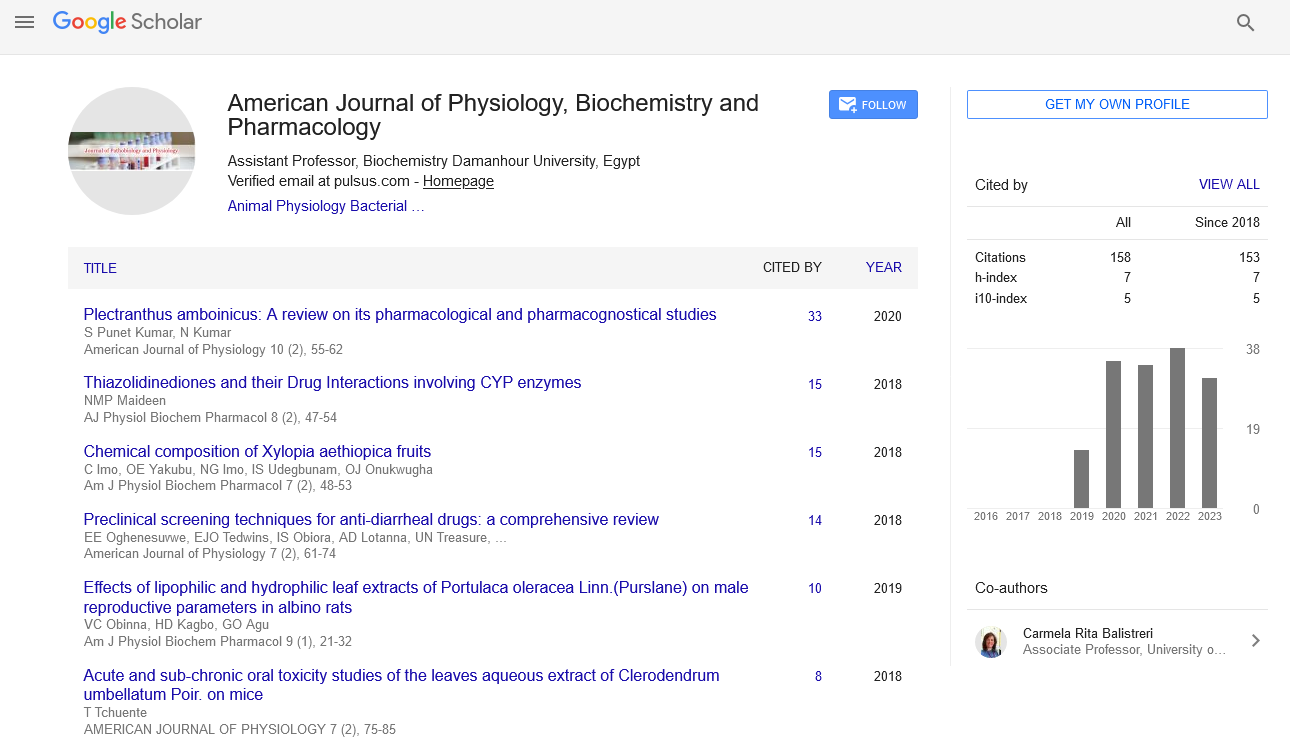Opinion Article - American Journal of Physiology, Biochemistry and Pharmacology (2024)
Nanotechnology’s Role in the Future of Medicine: Its Drug Delivery and Diagnostics
Ruslan Iwaski*Ruslan Iwaski, Department of Immunobiology, Yale University, New Haven, USA, Email: iwaskir@yale.edu
Received: 20-Aug-2024, Manuscript No. AJPBP-24-148473; Editor assigned: 22-Aug-2024, Pre QC No. AJPBP-24-148473 (PQ); Reviewed: 05-Sep-2024, QC No. AJPBP-24-148473; Revised: 13-Sep-2024, Manuscript No. AJPBP-24-148473 (R); Published: 23-Sep-2024
Description
Nanobiotechnology is an interdisciplinary field that combines principles from nanotechnology and biology to create innovative solutions for a variety of applications, including medicine, environmental science, and agriculture. By manipulating materials at the nanoscale—typically between 1 and 100 nanometres—scientists can develop novel materials and devices that exhibit unique properties and functions. This emerging field has the potential to revolutionize numerous sectors, particularly healthcare, by enabling new diagnostic methods, therapeutic strategies, and drug delivery systems.
Nanotechnology involves the design, production, and application of structures, devices, and systems by controlling shape and size at the nanometre scale. For instance, nanoparticles may demonstrate enhanced reactivity, increased strength, or altered electrical conductivity. These unique characteristics arise from the high surface area to volume ratio and quantum effects, making nanomaterials particularly valuable in a range of applications.
Nanobiotechnology in medicine
One of the most existing applications of nanobiotechnology lies in the medical field. Researchers are leveraging nanotechnology to develop advanced drug delivery systems that can improve the efficacy and reduce the side effects of therapies. For example, nanoparticles can be engineered to encapsulate drugs and release them in a controlled manner, allowing for targeted therapy that minimizes harm to surrounding healthy tissues.
In cancer treatment, for instance, nanoparticles can be designed to target tumour cells specifically, delivering chemotherapeutic agents directly to the cancer site. This targeted approach not only enhances the therapeutic effect but also reduces the toxicity often associated with conventional chemotherapy. Additionally, nanoparticles can be used as imaging agents in diagnostic techniques such as magnetic resonance imaging (MRI) and Computed Tomography (CT), improving the sensitivity and specificity of disease detection.
Diagnostic applications
Nanobiotechnology has also clear the route for innovative diagnostic tools. Nanosensors and nanobiosensors are being developed to detect specific biomolecules associated with diseases at very low concentrations. These devices can provide rapid and sensitive detection of pathogens, cancer biomarkers, and other health indicators, facilitating early diagnosis and treatment.
For example, gold nanoparticles can be functionalized with antibodies that bind to specific cancer biomarkers. When these nanoparticles interact with the target biomolecule, they produce a measurable signal, such as a color change, which can be detected and quantified. This technology has the potential to significantly improve the early detection of various diseases, leading to better patient outcomes.
Environmental and agricultural applications
Beyond healthcare, nanobiotechnology holds potential for environmental remediation and sustainable agriculture. Nanoparticles can be utilized to remove pollutants from water and soil, enhancing the efficiency of clean-up efforts. For instance, iron nanoparticles have been shown to effectively degrade organic contaminants, making them valuable tools in environmental remediation projects.
In agriculture, nanobiotechnology can improve crop productivity and health. Nanoparticles can be used to deliver fertilizers, pesticides, and herbicides more effectively, reducing the amount of chemicals needed and minimizing their environmental impact. Additionally, nanotechnology can facilitate the development of smart sensors that monitor soil health and crop conditions, allowing for precision farming techniques that optimize resource use.
Challenges and future directions
Despite its potential, the field of nanobiotechnology also faces several challenges. Concerns regarding the safety and toxicity of nanomaterials must be addressed, as their small size and unique properties may lead to unforeseen biological interactions. Regulatory frameworks will need to evolve to ensure that Nano biotechnological products are safe for human health and the environment.
Furthermore, interdisciplinary collaboration among scientists, engineers, and regulatory bodies is essential to advance the field and translate laboratory research into real-world applications. Continued investment in research and development will be critical for overcoming existing barriers and unlocking the full potential of nanobiotechnology.
Conclusion
Nanobiotechnology represents a frontier in science that combines the principles of nanotechnology and biological sciences to create innovative solutions for various applications. With its potential to revolutionize medicine through advanced drug delivery systems and diagnostics, as well as its applications in environmental remediation and agriculture, nanobiotechnology holds significant promise for improving quality of life. As research progresses and challenges are addressed, this interdisciplinary field is poised to make a profound impact on health, sustainability, and the overall wellbeing of society.






